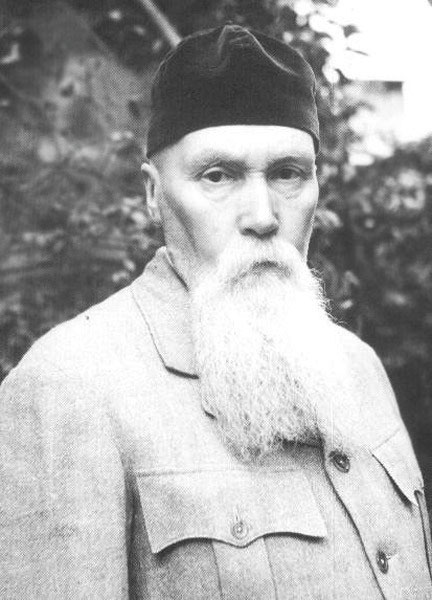"Nicholas Roerich: konstnär - fredsaktivist - arkeolog - poet - mystiker" is an art book published in 2007 by the Swedish branch of the Theosophical Society Adyar. The bilingual text (Swedish and English) is rather short, and the paintings shown aren't really analyzed. The book is probably intended as a "teaser trailer". It was published 60 years after Roerich's death, probably no co-incidence.
Roerich, a Russian emigre who lived in the United States, was a very colorful character. The book "Red Shambhala" by Andrei Znamenski even claims that he was a double agent, secretely working on behalf of both Soviet and American intelligence services! Roerich had good relations with the Adyar branch of Theosophy, but also founded (together with his wife Helena Roerich) a new religious movement called Agni Yoga.
Roerich is said to have painted over 7,000 paintings, so selecting a representative sample for this book (only 120 pages long) must have been hard. Personally, I think there are too few religious paintings in this volume, and too many showing Tibetan castles or empty Himalayan hills, but YMMV. Roerich was clearly enamored of Ladakh, a remote region of India, and promoted Notovitch's "The Life of Saint Issa", supposedly a lost gospel kept by the Buddhist monks at a monastery in this area.
The religious motifs are drawn from both Orthodox Christianity, Catholic ditto, Hinduism and Buddhism. There is also a painting of Mohammad meeting Gabriel. Even the Christian and Muslim motifs often look "Tibetan", suggesting either syncretism or that Roerich was completely smitten by the mighty Himalayas...
Recommended, if you live in Sweden and know next to nothing about Nicholas Roerich and his art.

Jag tyckte väl att namnet Roerich lät bekant.. Så jag letade lite - det var precis som jag trodde.
ReplyDeleteDet förekommer flera gånger i HP Lovecrafs roman "At the mountains of madeness".
Bland annat dessa två.
'The last lap of the voyage was vivid and fancy-stirring, great barren peaks of mystery looming up constantly against the west as the low northern sun of noon or the still lower horizon-grazing southern sun of midnight poured its hazy reddish rays over the white snow, bluish ice and water lanes, and black bits of exposed granite slope. Through the desolate summits swept raging intermittent gusts of the terrible antarctic wind; whose cadences sometimes held vague suggestions of a wild and half-sentient musical piping, with notes extending over a wide range, and which for some subconscious mnemonic reason seemed to me disquieting and even dimly terrible. Something about the scene reminded me of the strange and disturbing Asian paintings of Nicholas Roerich, and of the still stranger and more disturbing descriptions of the evilly fabled plateau of Leng which occur in the dreaded Necronomicon of the mad Arab Abdul Alhazred. I was rather sorry, later on, that I had ever looked into that monstrous book at the college library.'
”'From these foothills the black, ruin-crusted slopes reared up starkly and hideously against the east, again reminding us of those strange Asian paintings of Nicholas Roerich; and when we thought of the damnable honeycombs inside them, and of the frightful amorphous entities that might have pushed their foetidly squirming way even to the topmost hollow pinnacles, we could not face without panic the prospect of again sailing by those suggestive skyward cave-mouths where the wind made sounds like an evil musical piping over a wide range."'
Wow! 100% Lovecraft. Fast jag tycker inte att Roerichs målningar är särskilt skrämmande. Jag undrar om Lovecraft *verkligen* tyckte det?
ReplyDelete